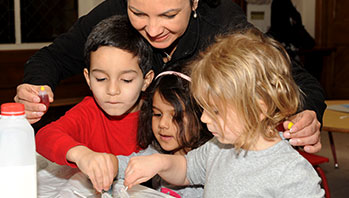- camera (optional)
- clipboards
- digging tool
- markers
- paper
- pen
- scissors
- sticks
- water containers (plastic buckets, bottles, and cups)
- white stick tags
- yarn
- flow
- stream
- squirt
- river
MA Standards:
Language/L.PK.MA.6: Use words and phrases acquired through conversations, listening to books read aloud, activities, and play.
MA Draft STE Standards:
Earth and Space Sciences/Earth’s Systems/ESS2.A: Observe, investigate, and classify the non-living materials, natural and human made, in their environment.
Physical Sciences/Matter and Its Interactions: Structure and Properties of Matter/PS1.A: Describe, compare, sort and classify objects based on observable physical characteristics, uses, and whether it is manufactured as part of their classroom play and investigations of the natural and human-made world.
Head Start Outcomes
Logic and Reasoning/Reasoning and Problem Solving: Classifies, compares, and contrasts objects, events, and experiences.
Science Knowledge/Conceptual Knowledge of Natural and Physical Worlds: Observes, describes, and discusses properties of materials and transformation of substances.
PreK Learning Guidelines:
English Language Arts/Language 2: Participate actively in discussions, listen to the ideas of others, and ask and answer relevant questions.
Science and Technology/Earth and Space Sciences 5: Compare and contrast natural materials such as water, rocks, soil, and living organisms using descriptive language.
Science and Technology/Physical Sciences 19: Explore, describe, and compare the properties of liquids and solids found in children's daily environment.
Small Group: Measure the Flow

© Commonwealth of Massachusetts, Department of Early Education and Care (Jennifer Waddell photographer). All rights reserved.
STEM Key Concepts: Water flows downhill; Different objects can be used to move water and change its direction; Water behaves differently on different surfaces: it gets absorbed on some surfaces and not on others and it gets absorbed differently on different surfaces; Taking measurements is a way of gathering information
ELA Focus Skills: Listening and Speaking, Vocabulary
Educator Prep: You may want to provide water smocks for children (garbage bags with holes for head and arms work well) to help keep children dry. Review guidelines about splashing and squirting.
Safety Tips:
- Remind children to wash their hands before and after the activity.
- Be aware of and check for poison ivy, poison sumac, and thorny or prickly bushes before gathering children in a designated area.
Tell children that today they will continue to explore rivers and streams in the dirt outside. Explain that this time children will measure how far water flows and record their findings.
- Take children out to the dirt area. Use a piece of yarn to demonstrate measuring how far the water travels and then cutting the yarn to that length.
- Then, invite different groups of children to measure their streams using yarn. Help them cut the pieces of yarn to the appropriate lengths and then compare the pieces to find the longest one (which river traveled the farthest).
- Ask children, What else could you use to measure how far your river flowed Encourage children to use other nonstandard ways of measuring their rivers.
- Gather and tag children’s pieces of yarn with their names before heading back inside. Display the results inside.
